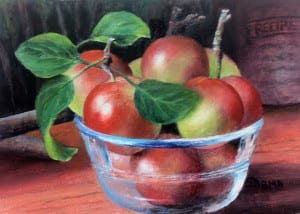
1. Paint your favorite drink – whether it’s a cup of tea, a pina colada, a steaming latte with lots of foam, or an ice cold beer – paint it in such a way that would show the viewer why it’s your favorite and how much you love it.
2. Go through the newspaper and find a photo – the first one that catches your eye – and paint your version of it – it could be abstract, realistic, finger-painted, or painted any way that might get your creative juices flowing for the next project.

4. Paint yourself as a person with the occupation you wanted as a child – did you want to be a fireman, a hairdresser, a bungee jumper, a police officer, a dancer? Give yourself a day as the person of your childhood dreams.
5. Do you love spaghetti? Eggs benedict? Chocolate Mousse? Strawberries? Your secret recipe? Paint it so everyone can taste it with you.
6. Repaint the first thing you ever painted. Just knowing that you now have a greater technical knowledge will help you paint that image with confidence.
7. Paint your worst habit – do you smoke, drink, eat too much chocolate? Paint in a way that will show how bad this habit is. Perhaps your painting, over time, will actually even help you quit your habit – if you even want to.
8. Paint about conformity – peas in a pod, ducks in a row, bananas in a bunch, etc. Make sure that part of your group doesn’t conform – for instance, leave one of the peas out of the pod.
9. Paint yours or your child’s favorite toy. Show some of the worn areas that clearly display how much it has been loved.
10. If you’re really hoping for some particular thing in life – paint it – maybe a cottage at the lake? A diamond ring? A new tool box? A particular make and model of vehicle? A child? Live your dreams through your painting.
Remember that at one time you only dreamed you could paint – now you truly can paint your dreams. Just make those first strokes that will put you back on your way – you can do it – you just need a little motivation. Hopefully you’ll find it here.
© Copyright · Susan Abma
Oil Painting
The Spirit Forges Ahead While the Brain Has To Figure It Out
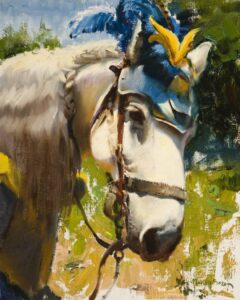

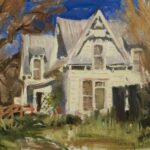
1.) An answer for countless viewers who have remarked that I certainly painted a lot of different subjects. Now I had a way to tie many of them together.
2.) A better understanding of my artistic hard-wiring, which
a.) I can use on occasion to find what I want to paint faster and more easily
b.) In a purely narcissistic way—a fascinating (to me) fact about myself, of which, after all these decades I had been unaware.
Every piece I do does not feature white on a color field, but now when it happens, I smile to myself and recognize it as another chapter in my love affair with this combination.
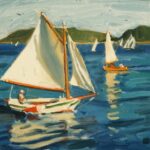
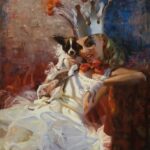
If you feel there may be a hidden theme in your work, or some unrecognized essence, or you wonder how all your painting threads connect, I have a suggestion: block out some time for a lunch with a savvy artist friend and leisurely peruse each other’s portfolios. A fresh eye and a frank discussion may uncover a powerful current flowing just under the surface of your paintings.
What is FINE art?

The question that Keith raises, though, “What is Fine Art, Anyway?” is an important question for all artists to answer, I believe, because all artists who are working seriously—and seriously working—very much want to produce art that is truly “fine.” The dictionary defines “Fine Art” as that which is “produced for beauty rather than utility.” Wow, if we take that definition as gospel, that definitely undersells some of the most magnificent illustrations from the course of human history that have been created for books, churches, posters, hymnals, and advertisements. Just to mention a few, consider those “fine” illustrations from the body of work of such greats as Michelangelo, Rembrandt, Gustave Doré, and Rick Griffin (The Bible ) N.C. Wyeth ( Last of the Mohicans, Treasure Island), Howard Pyle (Robin Hood, King Arthur), Rockwell Kent (Moby Dick), Norman Rockwell (“The Four Freedoms,” “The Problem We All Live With”). Even my favorite artists, who probably created the first profession known to man, the cave artists (Lascaux, Altamira, the Magdalenians) might have been creating their art for utility—hunting and animal worship—or not. Perhaps it was the beauty of the forms themselves that captured their imagination, which in turn inspired them to capture that beauty in charcoal.
From the enduring quality of these artworks, it would appear that all those artists mentioned above—whose works were “illustrations” for definite purposes of dissemination—were intent on creating beauty within and emanating from those artworks, which then became “useful” (having a broad impact and appeal) as much as they were truly “beautiful.” How could those artists have captured the beauty of human form, its costume, the elegant turn of a whale’s fin, the power of a bison’s charge, unless they, too, had—as is very evident in Keith Bond’s work—“a reverence for the world in which we live”—and a spirit of both “exploration and veneration.” In my own work, I am also hoping that that same spirit of reverence for creation and its Creator is both alive and evident.

Fine artists learn the foundational skills of effective design, composition, color choice and more because they know that those artistic choices, when effectively employed, will create symbolism, evoke emotion, and convey meaning. It is the constant honing of their craft that will produce “fine” works of art that will inspire and impact an audience, whether the channel for that art is a painting, a book, a sculpture, or an advertisement. “Fine” art is simply that which is finely expressed and executed.
Thanks, Keith, for your post. It helped me to answer some of my own questions about what I am doing , and further clarify in my own mind why the arts and dedicated artists—“fine,” illustrators, or otherwise—are all invaluable to our culture, and to our civilization.
Creating Better Digital Images of your Paintings. How to Ensure your Masterpiece is Best Represented Online and in Print
Most of us have had the experience of taking a photo of our painting, only to find out that it’s a distorted, too light/too dark, too blue, too red (insert your own adjective here) version of our beautiful painting. Then we go to Photoshop ( if we even know what kind of “animal” that is) to try and manipulate the image to make it look like the original. At the end of the session, we end up with an even worse image than we started with! How frustrating!
Well, Susan Abma and Jerry Goroski have some great tips on how to make the process of photographing your paintings (almost) painless!
Artists these days must do so many things – take photos of their work, post to Facebook , update their website, blog, etc. the list goes on and on…. all these activities leave limited time to actually create art. So how do we make sure we spend time painting, instead of manipulating technology? One way is to take better photos of our paintings. Here are some guidelines:
A good camera is an absolute must
What is a good camera? One with a glass lens. With cameras, as with most things in life, you get what you pay for. A cheap camera has a plastic lens, which distorts the image. A camera with a glass lens will give you a detailed, sharp, intense image. Buy the best camera you can afford. As a general guideline, a camera costing at least $300-$400 will have a glass lens.
Never use an IPad or Iphone image for print
The resolution is not high enough, and you will get a grainy, distorted image every time
Lens Tips
A longer lens, further back takes a sharper image than a 15mm lens close up. Get a zoom lens – at least a 15-85mm.
Lighting and setting up paintings
Using photo lamps indoors can change the colors of your painting dramatically. Susan and Jerry recommend taking your painting outdoors on an overcast day or in shade (but not deep shadow). Put an easel in a perfectly straight vertical position (measure to make sure it’s perfectly vertical). Put your camera on a tripod. Use of gray card (if one can be found) is recommended to calibrate the color. Another way to calibrate color is to place a piece of white foam core in front of the camera on a tripod exactly square to your image, and take a photo of that. Your camera will now have a guideline for white, and will adjust all the other colors accordingly.
Always take your painting out of the frame to avoid cast shadows. It does not matter what color you choose to put behind the easel. Again, make sure your painting on the easel is in a perfectly vertical position, you want to limit having to crop the image. Try to keep your camera at the same angle (vertically) as your painting. This will help in eliminating glare.
Back up your camera!. Shoot your photo from farther away, with a longer lens. That’s it!.
If your image quality is not where it should be, retake the photo, rather than trying to manipulate the image in Photoshop. Take as many shots as you can, so you have lots to choose from later on.
Manipulating images in Photoshop
If your image quality is bad, there is not much a printer can actually do with your image. Try to avoid extensive Photoshop manipulation at all costs, unless you are a Photoshop super-user (expert). All computer monitors are different, so the color you see on one, will not necessarily match the color on another monitor. If you have several computers, check the image on all of them. Manipulate the image in Photoshop by very small percentages, because small % changes alter the image dramatically. Overly manipulated shots usually come out very dark and muddy off the press.
When manipulating images in Photoshop, DO:
- Darken images
- Lighten images
- Sharpen images
DON’T:
- Manipulate color, unless you are a Photoshop expert. Just try to take a better photo!
- Adjust light/dark curves more than 2% either way. Adjusting by a higher percent will result in grainy images coming from the printing press.
- Adjust color in curves. If you need to adjust color, or light/dark by a large percentage, take another photo!
Photoshop is a very expensive program to buy. If you do not have Photoshop on your computer, a cheaper program will do just fine for the above manipulation of images. No need to invest in Photoshop. Save your money for a better camera!
Jpegs vs. TIFs
Most printing facilities require images in TIF format, rather than Jpegs. You can save your image as a TIF file in your computer, but the image needs to be a higher resolution – aim for a resolution of 300. When you change the resolution of your image in Photoshop, if resolution is increased 4 times, the other dimensions need to decrease 4 times. That is the way to obtain a crisp image. Normally, the image from your camera will be in a resolution of 72. Keep your original (unchanged) image file, because when you manipulate a file, it completely changes the image. Save the manipulated files under another name.
Closing thoughts
Final words of advice from Susan and Jerry – If you can at all afford to have your work professionally photographed, do it. Otherwise, spend more time learning how to take good photos, than learning how to manipulate Photoshop!
The Technique of Honesty

As artists we all long to convey with truth what we observe before us, what catches our breath and our attention. I’ve always believed that painting is an outward expression and visual record of what we are paying attention to in life. It can be as grand as a complex inspiration that comes forth from our imagination or as simple as an observational response to color, light and form. It can be capturing the essence of a person or place you love or an introspective feeling within yourself.
I find painting from life to be a balance of analytical observation and intuitive response. Establishing the essential structural forms, maintaining a hierarchy of elements and harmonizing that which is being emotionally conveyed in the moment.
Being attentive to the subtle honesty of emotion resonating from the person being painted and the response that we bring as the artists, all the while harnessing our tools at hand in the form of pigments and brushstrokes, is what makes painting from life so enthralling. Even when painting a landscape we are dealing with life caught in a moment, a moment that will never be the same again and that too has palpable honest emotion that we hope to imbue the painting with.
It’s not what you look at that matters, it’s what you see.
– Henry David Thoreau

When teaching, aside from value and color, one of the most important aspects that I am constantly reminding students of is to be aware of what they are holding in their minds during the process of painting. We all know to keep our palettes clean and avoid muddy color, but oftentimes the challenge lies in avoiding muddy thoughts while painting. Thoughts like, “I hope I don’t mess this up”, “I’m frustrated” or “I can’t get this right”, etc.
We all, as artists, go through a gambit of emotions while painting; if those thoughts and beliefs about what you are doing (or attempting to do) are muddy with negativity, your painting will reflect that.
As Robert Henri said in the book The Art Spirit:
The brush stroke at the moment of contact carries inevitably the exact state of being of the artist at that exact moment into the work, and there it is, to be seen and read by those who can read such signs, and to be read later by the artist himself, with perhaps some surprise, as a revelation of himself. For an artist to be interesting to us he must have been interesting to himself. He must have been capable of intense feeling, and capable of profound concentration. He who has contemplated has met himself, is in a state to see into the realities beyond the surface of his subject. Nature reveals to him, and seeing and feeling intensely, he paints, and whether he wills it or not each brush stroke is an exact record of such as he was at the exact moment the stroke was made.

I’ve realized now, that as important as the fundamentals of painting are and while they must be practiced regularly with vigor and attentiveness, the strongest technique is honesty in all veins. Honesty to what is being observed, looking for truth in shapes and color temperatures and how they relate, but also being honest to how I am responding to what I’m seeing and bringing to the moment myself as the artist. As I explained once to a class of portrait painters, you cannot paint a portrait of someone with a soft ethereal expression on their face by angrily painting with a furrowed brow yourself. What you are choosing to embody will always show up onto the canvas… you must embody that which you wish to convey.

This quote hangs in my studio as a reminder:
Seek patience and passion in equal amounts. Patience alone will not build the temple. Passion alone will destroy its walls.
– Maya Angelou

I remind students in my workshops, “there is no one in history who has the same exact sensitivities as you… what are you bringing to the painting session? How do YOU see? Let that honesty be your strongest ‘technique.'” Learn the ABC’s of painting — drawing value, composition, color and edges — but then write your novel with paint.
Tell me, what is it you plan to do with your one wild and precious life?
~ Mary Oliver (American Poet)